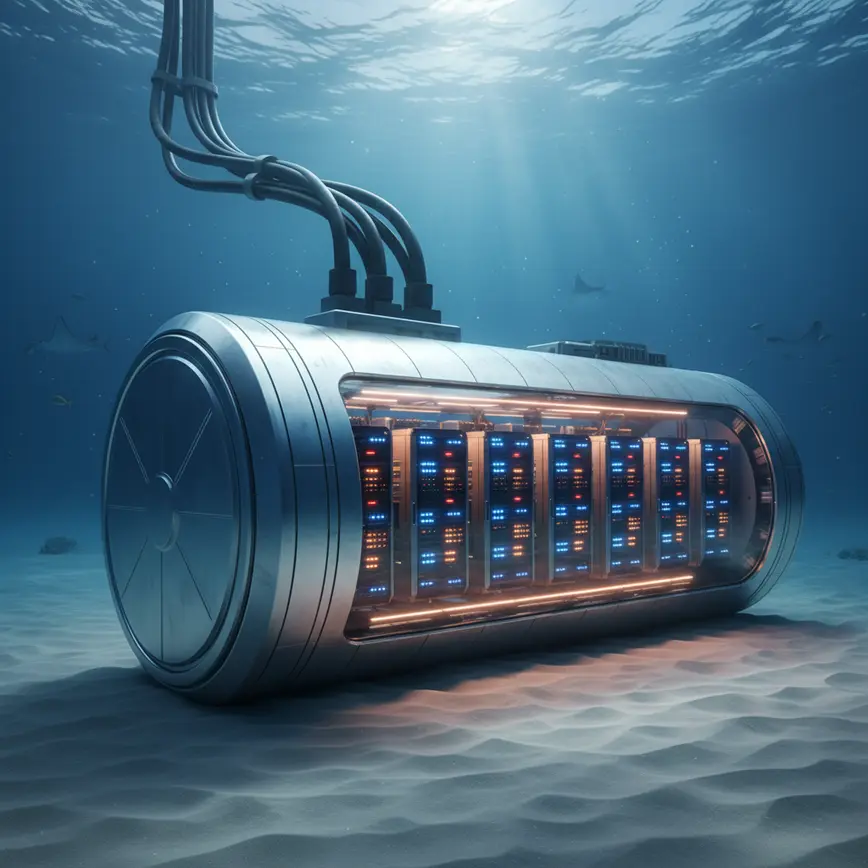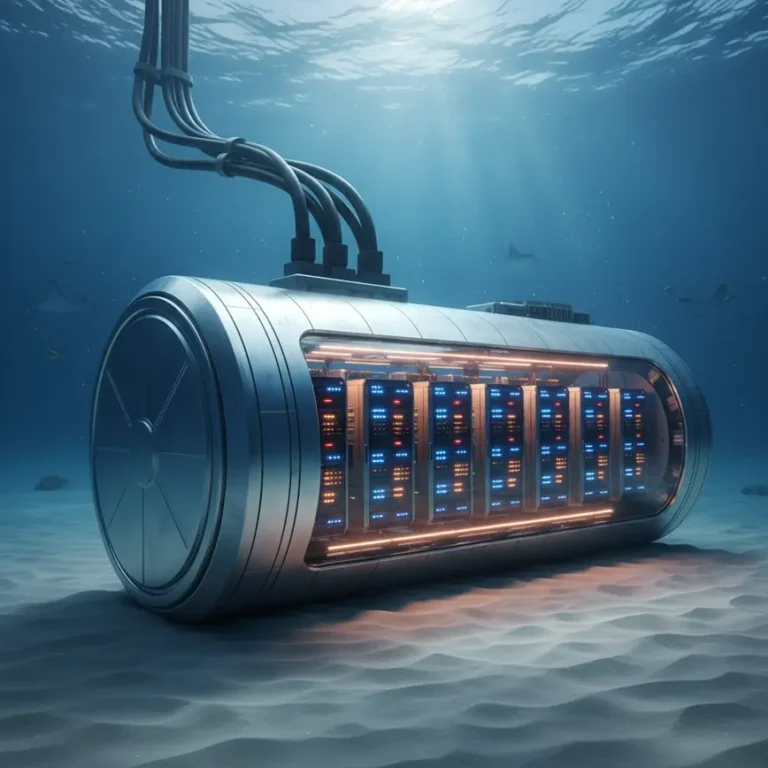
🔑 Key Takeaway
An underwater data center is a self-contained, submerged facility that leverages the ocean’s naturally cold temperatures for cooling, offering significant energy efficiency and reliability benefits.
- Enhanced Reliability: Submerged servers, like those in Microsoft’s Project Natick, have shown a failure rate 8x lower than land-based counterparts.
- Energy Efficiency: Utilizes natural seawater for cooling, drastically reducing the energy costs associated with traditional air-cooled data centers.
- Major Players: Microsoft and China are leading the development, with Microsoft focusing on experimental research and China launching the first commercial-scale project.
- Significant Risks: Major concerns include environmental impacts on marine ecosystems, physical and cybersecurity vulnerabilities, and geopolitical espionage threats.
Read on for a complete guide to this emerging technology.
An underwater data center is a fully submerged facility that uses the ocean’s natural cooling properties to operate. This article explores the significant benefits, the hidden environmental and security risks, and the major players like China and Microsoft. As our data needs grow, tech giants are seeking radical solutions. This technology could change how the internet works, but its rapid development comes with critical questions. We will provide an expert-led deep dive into the viability, technology, and dangers of this new frontier.
The core problem data centers face is heat, and cooling can account for up to 40% of a traditional data center’s energy consumption. This article will analyze the successful experiments by Microsoft and contrast them with China’s large-scale commercial ambitions. We will cover how these facilities work, identify the key players in this emerging field, and take a critical look at the associated risks to provide a comprehensive overview of this groundbreaking technology.
ℹ️ Transparency: This article explores the technology and risks of underwater data centers based on scientific research and industry reports. All information is based on verified studies and reviewed by an industry expert. Our goal is to inform you accurately.
How an Underwater Data Center Works
An underwater data center works by enclosing servers in a sealed, waterproof vessel and submerging it in the ocean, using the surrounding cold seawater as a natural, constant coolant. This approach may eliminate the need for the massive, energy-intensive chillers and air conditioning systems used in land-based facilities. Data and power are typically supplied through a hybrid submarine cable connected to a shore station. To reduce corrosion and hardware failure, the internal atmosphere is often replaced with an inert gas like nitrogen. Microsoft’s Project Natick noted the use of a nitrogen atmosphere contributed to enhanced reliability. This elegant data center cooling solution is the core of its efficiency, but powering and connecting these submerged systems presents unique challenges.
The Core Concept: Natural Cooling and Efficiency
The cooling process involves a heat exchange system where internal heat from the servers is transferred through the vessel’s walls directly into the surrounding water. This method is highly efficient and can be measured by its Power Usage Effectiveness (PUE), a metric where a score of 1.0 indicates perfect efficiency. Some underwater designs can achieve a PUE near 1.07, a significant improvement over the 1.5-1.7 average for many traditional data centers. Research from a 2025 analysis in the International Journal of Scientific Research & Engineering Trends of 50 data centers found that liquid-cooled systems were over 20% more energy-efficient than traditional air-cooled facilities, suggesting the potential of concepts like the underwater AI data center. While cooling is efficient, getting data to and from the seafloor is another matter.
Connectivity and Power Challenges
Hybrid submarine cables are central to the operation, transmitting both fiber optic data and electrical power from a shore-based station. Placing data centers closer to coastal population centers can also reduce latency, a critical factor for many digital services. However, these essential underwater data cables are vulnerable. They can be damaged by accidental causes like fishing trawlers and ship anchors, or they can be subject to deliberate tampering. According to a report by Recorded Future, anchor dragging and other unknown causes account for a large percentage of submarine cable damage incidents. This innovative approach has sparked a new race among the world’s tech giants.
The Global Race: Microsoft vs. China vs. The World
The development of submerged data centers has become a new frontier for technological competition, with two clear leaders emerging: Microsoft, with its research-driven experimental approach, and China, with its aggressive push toward commercial-scale deployment.
Microsoft’s Project Natick: A Successful Experiment?
Microsoft’s Project Natick was a pioneering research initiative designed to test the feasibility of submerged data centers. The project’s second phase involved deploying an 864-server vessel off the coast of Scotland from 2018 to 2020. The microsoft underwater data center results were highly encouraging. In its two-year study, Microsoft researchers observed that the submerged servers had a failure rate just 1/8th that of their land-based control group. This remarkable reliability was attributed to the inert nitrogen atmosphere, which reduced corrosion, and the complete lack of human interference. While Microsoft proved the concept, China is taking it to a commercial scale.
China’s Commercial Ambitions: The Hainan Project
China has launched the world’s first commercial china underwater data center off the coast of Hainan island. This ambitious project involves a plan to deploy up to 100 modules, each capable of housing hundreds of servers. The facility is designed to support the massive data processing needs of AI, big data, and 5G workloads for the region. As reported by the South China Morning Post, the Hainan project is a key part of the province’s 14th Five-Year Plan, aiming to leverage the technology to power everything from regional smart city initiatives to developing more powerful AI tools. Microsoft and China are the clear leaders, but other tech giants are watching closely.
Other Tech Giants and Future Projects
While Microsoft and China are the most visible players, other technology leaders are exploring similar concepts. Companies like Google and Amazon have filed patents related to submerged or water-cooled data center technologies, though they have not yet announced full-scale projects comparable to Project Natick or the Hainan facility. The demonstrated success of these early projects is likely to spur further investment and innovation across the sector as the demand for efficient, high-density computing continues to grow. However, this rapid innovation brings to light a darker side of operating critical infrastructure on the ocean floor.
| Feature | Microsoft Project Natick (Phase 2) | China Hainan Project |
|---|---|---|
| Type | Experimental Research | Commercial Operation |
| Scale | 864 Servers (1 vessel) | 100+ Vessels Planned |
| Stated Goal | Prove feasibility & reliability | Provide commercial AI/5G services |
| Key Finding | 1/8th server failure rate vs. land | PUE of 1.1 (highly efficient) |
| Status | Concluded (2020) | Operational & Expanding |
The Dark Side: Uncovering the Hidden Dangers
While the efficiency gains are compelling, the deployment of data centers on the ocean floor introduces a complex array of environmental, security, and geopolitical risks that are not yet fully understood.
Environmental Impact: Beyond “Green” Marketing
The primary environmental benefit is energy efficiency, but the long-term ecological impact is a significant unknown. The constant dissipation of heat, even if minor, could alter local marine ecosystems. A 2024 study in BioScience warns that artificial marine structures can alter local water temperature profiles, potentially impacting the metabolic rates and ecosystem functions of marine life in the immediate vicinity. Furthermore, the potential for corrosion and material breakdown over the lifespan of a facility raises concerns about the release of toxic substances. A comprehensive analysis of the underwater data center environmental impact is needed to ensure the “green” label is fully warranted. Beyond the ecological questions, the physical security of these assets is a major concern.
Critical Security Vulnerabilities
The remote and submerged nature of these facilities creates unique data security challenges. They are potentially vulnerable to physical tampering from submarines, remotely operated vehicles (ROVs), or specialized divers operating in areas that are difficult to monitor. The power and data cables represent single points of failure, susceptible to both accidental cuts and deliberate sabotage. According to a 2023 CSIS report, the physical threat is substantial, with specialized submarines capable of cutting or tapping cables actively operating near critical undersea infrastructure. Furthermore, the network management systems are potential targets for cyber-physical attacks, which could lead to data interception or physical damage while creating and processing content(https://thetechabc.com/ai-tools-youtube-channel). These security risks are amplified when placed in the context of international politics.
The Geopolitical & Espionage Threat
Data is a sovereign asset, and placing critical infrastructure on the seabed introduces serious risks of state-sponsored espionage. An underwater data center could potentially be tapped or monitored with a lower chance of detection compared to a land-based facility. This risk is magnified in contested waters like the South China Sea, where placing such infrastructure creates immense strategic vulnerabilities. China’s national strategy of civil-military fusion raises the possibility that commercial data centers could serve dual-use purposes for surveillance or military operations. Analysts from the Air University’s Journal of Indo-Pacific Affairs note that under this strategy, commercial infrastructure can be leveraged for state purposes, a concern echoed in U.S. threat assessments of espionage risks. These complex questions are at the forefront of discussions about this technology.
FAQ – Your Questions Answered
What are the security concerns of underwater data centers?
The main security concerns are physical tampering, data espionage, and sabotage. Because they are in remote, submerged locations, they are vulnerable to undetected access by submarines or ROVs. Their critical power and data cables can be accidentally or deliberately cut, and the systems themselves could be targeted by state-sponsored cyberattacks to intercept sensitive data or disrupt operations.
How many underwater data centers are there?
As of late 2025, there are very few operational underwater data centers. Microsoft’s Project Natick was a successful experiment that has now concluded. China has launched the world’s first commercial-scale project off the coast of Hainan. While other companies are exploring the technology, the number of active, permanent installations remains in the single digits, though this is expected to grow.
What is the energy efficiency of underwater data centers?
They are extremely energy-efficient, primarily due to natural cooling. By using cold seawater, they nearly eliminate the need for power-hungry chillers, achieving a Power Usage Effectiveness (PUE) as low as 1.07. For comparison, traditional land-based data centers average a PUE of 1.5 or higher, meaning a much larger percentage of their energy is used for cooling rather than computing.
How do underwater data centers work?
They work by placing servers in a sealed, waterproof vessel on the ocean floor. A hybrid submarine cable provides power and fiber-optic connectivity to the shore. The surrounding cold seawater naturally absorbs the heat generated by the servers, which is transferred through a heat exchanger on the vessel’s hull. This process provides constant, free, and highly efficient cooling.
What are the disadvantages of underwater data centres?
The main disadvantages are difficult maintenance, environmental risks, and security vulnerabilities. Physical repairs require retrieving the entire vessel, which is costly and complex. The long-term impact of heat dissipation on marine life is not fully understood, and the remote locations make them potential targets for physical sabotage, cable cutting, and data espionage by state actors.
Limitations, Alternatives, and Professional Guidance
Research Limitations
It is important to acknowledge that this technology is still in its infancy. Long-term operational and environmental data spanning a decade or more is not yet available. Most public information comes from a few pioneering projects, primarily from Microsoft and China, and performance could vary significantly with different designs, depths, and marine environments. There is a clear need for more independent, peer-reviewed research on the ecological impact of sustained heat dissipation and the risks of material degradation over time. Given these unknowns, it’s important to consider other advanced cooling methods.
Alternative Approaches
Several alternative cooling technologies offer similar efficiency benefits without the associated marine risks. Land-based liquid immersion cooling, where servers are submerged in a non-conductive dielectric fluid, can achieve comparable PUE levels. Another approach is geothermal cooling, which involves building data centers that leverage naturally cool air from caves or other geothermal sources. The most suitable approach often depends on specific factors like geography, project scale, and security requirements. For organizations considering these technologies, professional guidance is crucial.
Professional Consultation
Companies exploring large-scale data center solutions are advised to consult with experienced data center engineers and environmental impact assessors. Key discussion points should include a thorough analysis of the total cost of ownership, the development of robust security protocols for remote infrastructure, and ensuring compliance with all relevant maritime and environmental regulations. A comprehensive risk analysis is a critical step before investing in such novel and complex infrastructure. With this balanced perspective, let’s summarize the key insights.
Conclusion
The underwater data center represents a major leap in efficiency and reliability, presenting a novel solution to the critical cooling problem that has long plagued the industry. However, these considerable benefits come with significant and still unresolved environmental, security, and geopolitical risks. The future of this technology likely depends on the industry’s ability to address these challenges responsibly and transparently.
To stay informed on deep dives into emerging technologies like this, it is important to follow expert analysis and industry developments. The Tech ABC provides in-depth coverage to help you understand the innovations and risks that are shaping the future of our digital world.
References
- Microsoft Project Natick Official Research: https://natick.research.microsoft.com
- IJSRET PUE Analysis: https://ijsret.com/wp-content/uploads/2025/03/IJSRETV11issue2_798.pdf
- Center for Strategic and International Studies (CSIS): https://www.csis.org/analysis/safeguarding-subsea-cables-protecting-cyber-infrastructure-amid-great-power-competition
- BioScience Journal on Marine Structures: https://academic.oup.com/bioscience/article/75/2/172/8016612
- Air University Journal of Indo-Pacific Affairs: https://www.airuniversity.af.edu/JIPA/Display/Article/3588497/securing-the-digital-seabed-countering-chinas-underwater-ambitions/
- South China Morning Post (Hainan Project Data): https://www.scmp.com/economy/china-economy/article/3328063/china-launches-worlds-first-commercial-underwater-data-centre-hainan







